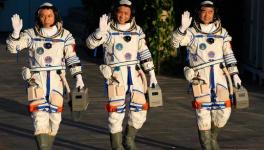3 Chinese Astronauts, Including a Woman, Enter Space Station on 6-Month Mission
Beijing: Three Chinese astronauts, including a woman, on board the Shenzhou-13, have entered the space station core module Tianhe on Saturday, the country's space agency said, hours after the spaceship was successfully launched for a record six-month mission.
The three astronauts -- Zhai Zhigang, Wang Yaping and Ye Guangfu -- successfully docked with the radial port of the under-construction space station core module Tianhe.
They will stay in the space station for six months to complete its construction -- the longest manned mission in China's history. Wang is the first Chinese woman astronaut to visit China's space station.
The spaceship, launched on early Saturday morning, completed orbital status and conducted a fast-automated rendezvous and docking with Tianhe at 6:56 am (Beijing Time), forming a complex together with the cargo crafts Tianzhou-2 and Tianzhou-3.
The whole process took approximately 6.5 hours, the China Manned Space Agency (CMSA) said.
The spaceship, atop a Long March-2F carrier rocket, was launched from the Jiuquan Satellite Launch Centre in northwest China's Gobi Desert.
This is the second manned mission for China’s space station, which is under construction. Earlier three other astronauts Nie Haisheng, Liu Boming and Tang Hongbo returned to earth on September 17 after a successful three-month stay in the space station module during which they carried out several tasks to build it.
Billed as the most prestigious and strategically important space project for China after the country's recent Mars and previous Moon missions, the low orbit space station would be the country's eye from the sky, providing round the clock bird's-eye view on the rest of the world.
The space station is expected to be ready by next year.
Once ready, China will be the only country to own a space station while the ageing International Space Station (ISS) is now a collaborative project of several countries. It is expected to be a competitor to the ISS and perhaps may become a sole space station to remain in orbit once the ISS retires.
The ISS is divided into two sections -- the Russian Orbital Segment (ROS), which is operated by Russia, and the United States Orbital Segment (USOS), which is run by the US as well as many other nations, including Japan and Canada.
China is building the space station by sending a series of space missions including the cargo craft, which docked with the Tianhe core cabin module.
The Tianhe was launched on April 29 and a cargo spacecraft with supplies on May 29.
Once ready, the station is also expected to be opened for China's close allies like Pakistan and for other international space cooperation partners.
Ji Qiming, assistant to the China Manned Space Agency (CMSA) director, said last month that besides close cooperation with Russia, China is also having bilateral cooperation exchanges with countries including France, Italy, Pakistan and others focussing on space experiments in fundamental physics, space medicine and space autonomy on the space station.
Separately, China and Russia also unveiled a roadmap to build a lunar space station, official media here reported. The station aims to develop research facilities on the surface of the moon, in orbit or both.
China's space station is also equipped with a robotic arm over which the US has raised concerns for its possible military applications.
The arm, which can be stretched to 15 metres, will also play a vital role in building the space station in orbit, Zhou Jianping, chief designer of China's manned space engineering project, had said.
Astronauts will team up with the robotic arm to make in-orbit space station construction and maintenance possible.
China in the past had launched several scavenger satellites fitted with robotic arms to gather and steer space debris so that it burns up in Earth's atmosphere.
The new space station will operate in low-Earth orbit at an altitude of 340-450 km above Earth's surface for more than 10 years.
The T-shape station has one core module at the centre and a lab capsule on each side. Each of the modules will weigh over 20 tonnes, with the total mass of the station expected to weigh about 66 tonnes.
Chinese President Xi Jinping, who spoke to the three astronauts of the Shenzhou-12 mission earlier, termed the project as an "important milestone" in the country's ambitious space exploration programme.
"The construction of the space station is a milestone in China's space industry, which will make pioneering contributions to the peaceful use of space by humanity," Xi had said.
Get the latest reports & analysis with people's perspective on Protests, movements & deep analytical videos, discussions of the current affairs in your Telegram app. Subscribe to NewsClick's Telegram channel & get Real-Time updates on stories, as they get published on our website.















